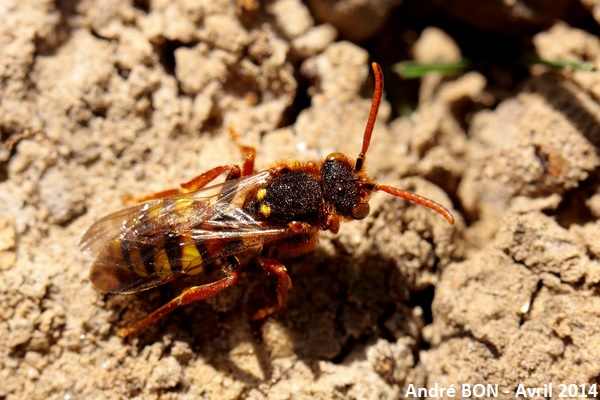
| Lathbury's Nomad (Nomada lathburiana (Kirby, 1802)) |

|
|
Scientific name: Nomada lathburiana (Kirby, 1802) Common name: Lathbury's Nomad French name: Order: Hymenoptera Family: Apidae Wingspan : 10 à 13 mm. Biotope: Places where nest solitary bees to parasitize: Parks and gardens, orchards, calcareous meadows, edges of cultivated areas, sandy soils. Geographic area: Europe except extreme northern regions and southern regions, Asia east to Kazakhstan. Observation period : Late March to early June. |
There are about 850 species in the Nomada genus worldwide with 193 listed as present in France. These are cuckoo bees which are used to parasitizing solitary bees, mainly those of the Andrena genus. They enter into the nest of the parasitized bees to lay one egg. The larva will first kill and eat the larva of the parasitized bee and then it will feed on stored food. Nomada lathburiana shows a uniform black scutum (middle segment of the thorax) without the reddish stripes found on Nomada flava, Nomada panzeri and Nomada signata. The scutellum (third segment of the thorax) bears two yellow or reddish spots. The abdomen is reddish on the first segment and then yellow and black. Females can show some reddish colour on the upper side of the following segments. The legs are reddish with some yellow markings, black coxae and some black colour on the hind femora. There are small, laterally flattened, spines at the apex of tibia 3. They look like small blades. There are also a strong reddish hairs on the head and thorax, mainly visible on females that you can recognized by their antennae made of 12 articles (including scape et pedicel). Males, with antennae of 13 articles, show small tubercles on each article of the antennae. Nomada lathburiana parasitize Andrena cineraria and Andrena vaga. Nomada goodeniana which also parasitizes Andrena cineraria has more yellow legs and does not show any reddish colour at the base of the abdomen. |
| [To know more about the Lathbury's Nomad] [Top] |

|
I have observed this cuckoo bee flying close to the ground in my garden, looking for the burrow of a solitary bee to parasitize. You can easily find Andrena cineraria and Andrena fulva in my garden. They dig small holes in the soil. This female Lathbury's Nomad has been very kind to make a short stop and land on the ground so that I can take a picture. All the useful criteria to identify the Nomada lathburiana species are visible except the short spines at the apex of tibias 3. I need to remember to look at this on my next observations. |